“On Wednesday, July 6, the first case of yellow fever came…By July 22 some 5,000 American men were on the sick list. By July 31, so many men were dying each day that General Shafter put a stop to formal military burials. The daily volleys of rifle fire over the new graves and the blowing of “Taps,” in the afternoon were bad for morale.”
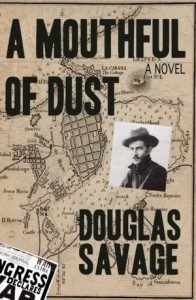 From the explosion of the U.S. battleship Maine in Havana Harbor on February 15, 1898, to the killings of prisoners by the Cubans and Spanish in the aftermath of the Protocol of Peace on August 12, 1898, American news correspondent Sam Carleton records his day-by-day actions during the Spanish-American War. America’s interests in acquiring Spanish territories, combined with the rebel Cuban movement to overthrow their Spanish rulers, has led to groups of Cubans fighting the Spanish while the Americans are also conducting operations. Black soldiers from units in the United States, perhaps identifying with the Cubans’ desire for freedom, have been anxious to help in this war, and a number of all-black regiments are also involved in the fight.
From the explosion of the U.S. battleship Maine in Havana Harbor on February 15, 1898, to the killings of prisoners by the Cubans and Spanish in the aftermath of the Protocol of Peace on August 12, 1898, American news correspondent Sam Carleton records his day-by-day actions during the Spanish-American War. America’s interests in acquiring Spanish territories, combined with the rebel Cuban movement to overthrow their Spanish rulers, has led to groups of Cubans fighting the Spanish while the Americans are also conducting operations. Black soldiers from units in the United States, perhaps identifying with the Cubans’ desire for freedom, have been anxious to help in this war, and a number of all-black regiments are also involved in the fight.
Sam Carleton is only “six weeks into his twenty-seventh year” when he arrives in Cuba, a five-foot six-inch, one hundred-twenty pound man with a bad cough, who feels that “his literary future is behind him.” The author of a book about the Civil War published in 1895, Carleton, a pseudonym for author Stephen Crane, has abandoned the idea of war as an epic, full of heroe s making courageous decisions and willingly sacrificing their lives for a cause. Instead, he focuses on the specific – the small, personal aspects of daily life among ordinary Union soldiers – describing how the soldiers feel, what they are thinking, and even, in some cases, their palpable fear. In The Red Badge of Courage, the book by Carleton/Crane, eighteen-year-old Henry Fleming quickly gives up his romantic vision of war when he sees it in all its stark, gory realism – full of the color of blood, the agony of the dying, the putrid smells of death, the ear-splitting screams, the thunder of weapons, and the seeming senselessness of it all. Henry runs away, his shame dominating the rest of this impressionistic novel as he tries to atone for his personal failure and for his betrayal of his duty.
s making courageous decisions and willingly sacrificing their lives for a cause. Instead, he focuses on the specific – the small, personal aspects of daily life among ordinary Union soldiers – describing how the soldiers feel, what they are thinking, and even, in some cases, their palpable fear. In The Red Badge of Courage, the book by Carleton/Crane, eighteen-year-old Henry Fleming quickly gives up his romantic vision of war when he sees it in all its stark, gory realism – full of the color of blood, the agony of the dying, the putrid smells of death, the ear-splitting screams, the thunder of weapons, and the seeming senselessness of it all. Henry runs away, his shame dominating the rest of this impressionistic novel as he tries to atone for his personal failure and for his betrayal of his duty.
Though he is in Cuba as a journalist, Carleton soon discovers that his own war in Cuba is almost identical to that of Henry Fleming, with some of the characters from The Red Badge of Courage appearing in new guises, characters from Crane’s real life taking roles in the story under different names, and George Gordon Fleming, the son of Henry Fleming, the fictional main character of The Red Badge of Courage, coming to life in a new story a generation later.
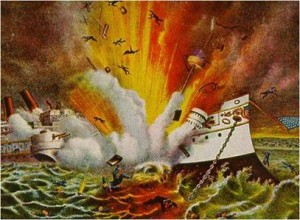 As Douglas Savage’s novel begins, Sam Carleton, in Havana in December, 1898, is getting ready to return home to the United States. The war has been over since August, but Carleton has remained in Havana to finish recording what he has seen. He suffers terribly from the effects of both malaria and yellow fever, along with the yet-undiagnosed tuberculosis which will kill him a year later. His mind wanders, and he sometimes becomes confused. Rosa Montoya, who has been at his side for the past year, accompanies him as he walks along the Havana waterfront, paying homage to the lives lost in the explosion of the USS Maine in January, 1898, its wreckage still visible. When Rosa shakes him from his stupor, “He [is] grateful that she [has] grabbed him before he drained out of sight into the pores of the street.” Back at his boarding house, Carleton relives his experiences during the Battle for San Juan Hill. His writing is vivid, as is his depiction of Lt. Col. Theodore Roosevelt, who grins after killing a Spanish regular: “Got this one myself…Popped him with this pistol my brother-in-law – damned navy man – salvaged from Maine, God bless her.”
As Douglas Savage’s novel begins, Sam Carleton, in Havana in December, 1898, is getting ready to return home to the United States. The war has been over since August, but Carleton has remained in Havana to finish recording what he has seen. He suffers terribly from the effects of both malaria and yellow fever, along with the yet-undiagnosed tuberculosis which will kill him a year later. His mind wanders, and he sometimes becomes confused. Rosa Montoya, who has been at his side for the past year, accompanies him as he walks along the Havana waterfront, paying homage to the lives lost in the explosion of the USS Maine in January, 1898, its wreckage still visible. When Rosa shakes him from his stupor, “He [is] grateful that she [has] grabbed him before he drained out of sight into the pores of the street.” Back at his boarding house, Carleton relives his experiences during the Battle for San Juan Hill. His writing is vivid, as is his depiction of Lt. Col. Theodore Roosevelt, who grins after killing a Spanish regular: “Got this one myself…Popped him with this pistol my brother-in-law – damned navy man – salvaged from Maine, God bless her.”
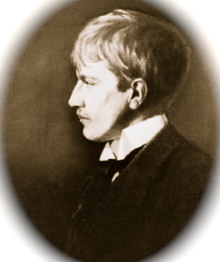
Time moves back and forth, in and out of the past, and in and out of Carleton’s imagination as his story of the Spanish-American War takes place. For months Carleton has moved throughout the countryside, observing battles, and he has much to say about the bravery of the black soldiers, who have been kept completely segregated throughout the war and are unlikely to receive any recognition at home for their bravery under fire. Four people travel with Carleton: Rosa Montoya; her unstable son Alfonso, a Cuban militant; her brother Francisco, a priest who has seen much more than he can possibly bear; and Maria Teresa, a young girl pregnant with Alfonso’s child. Most of the killings and rapes they see resemble gang violence more than battles. When peace is declared in August, the group fears that the Spaniards will murder their Cuban prisoners and vice versa, and they hurry into the countryside hoping to prevent that.
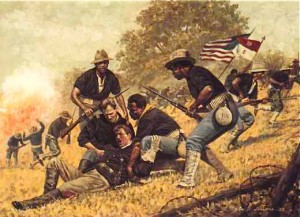 Another story evolves in parallel with the story of Sam Carleton. Appearing and reappearing without warning throughout this novel, George Fleming, son of Henry Fleming from The Red Badge of Courage, accompanied by Esther Slone, travels to a collapsed mine in western Pennsylvania to help rescue sixty trapped miners. Episodes in this trip constantly intrude into Carleton’s story in Cuba, showing similar themes and characters, as author Douglas Savage illustrates the mortality of Carleton’s illness, his unresolved issues regarding courage and its importance, and the power of imagination.
Another story evolves in parallel with the story of Sam Carleton. Appearing and reappearing without warning throughout this novel, George Fleming, son of Henry Fleming from The Red Badge of Courage, accompanied by Esther Slone, travels to a collapsed mine in western Pennsylvania to help rescue sixty trapped miners. Episodes in this trip constantly intrude into Carleton’s story in Cuba, showing similar themes and characters, as author Douglas Savage illustrates the mortality of Carleton’s illness, his unresolved issues regarding courage and its importance, and the power of imagination.
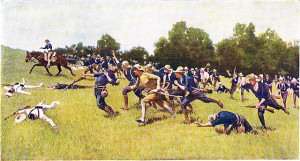
Filled with facts about the life of Stephen Crane, all of which are included in footnotes at the end of the book, the novel creates a powerful picture of Crane’s life. Every fact is verified, and many of the descriptions, borrowed from Crane’s books, are also cited. The life of Crane’s common-law wife, Cora Stewart (or Taylor), may have inspired the story of Rosa, while Esther Slone in George Fleming’s story is her antithesis. The author’s reason for using Sam Carleton as a pen name for Stephen Crane becomes clear in the dramatic ending. For readers who are familiar with The Red Badge of Courage, even minimally, this book is a literary feast, not just for its insights into Stephen Crane and his life, but also for the way Crane’s creativity may have influenced his mental state near the end of this life. Those who are unfamiliar with The Red Badge of Courage may wish to review it here for added insights into this unusual novel: http://en.wikipedia.org/
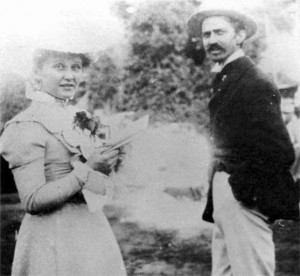
Photos, in order: The author’s photo by Elizabeth Gasper appears on his publisher’s website: http://nortiapress.com/
The explosion of the USS Maine occurred on Feb., 15, 1898, thought (erroneously) to have been the result of a Spanish mine in Havana Harbor. This was one event leading up to the declaration of war in April, 1898. Unknown artist. http://yellowjournalismsawar.blogspot.com
The portrait of Stephen Crane in 1894 was painted by his friend Corwin Linson: http://en.wikipedia.org
This painting of the Battle of Guasimas on June 24, 1898, by Don Stivers, shows the wounded Major Bell of the 1st Cavalry being attended by four soldiers, three of whom are black. Capt. C. G. Ayers and Pvt. Augustus Walley dragged him to safety. More information here: http://www.faqs.org
Frederic Remington’s “Charge of the Rough Riders at San Juan Hill,” from July 1, 1898, is in the Frederic Remington Art Museum in Ogdensburg, N.Y. http://en.wikipedia.org/
Cora Taylor Stewart Crane, Stephen Crane’s common-law wife (a brothel owner) is shown in this picture with Stephen Crane. http://www.jaxhistory.com
ARC: Nortia
